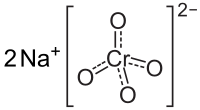Sodium chromate
 | |
| | |
| Names | |
|---|---|
| IUPAC name
Sodium chromate | |
| Other names
Chromic acid, (Na2CrO4), disodium salt Chromium disodium oxide Rachromate | |
| Identifiers | |
| 7775-11-3 | |
| ChEBI | CHEBI:78671 |
| EC number | 231-889-5 |
| |
| Jmol-3D images | Image |
| PubChem | 24488 |
| RTECS number | GB2955000 |
| |
| UN number | 3288 |
| Properties | |
| Na2CrO4 | |
| Molar mass | 161.97 g/mol |
| Appearance | yellow crystals |
| Odor | odorless |
| Density | 2.698 g/cm3 |
| Melting point | 792 °C (1,458 °F; 1,065 K) (anhydrous) 20 °C (decahydrate) |
| 31.8 g/100 mL (0 °C) 84.5 g/100 mL (25 °C) 126.7 g/100 mL (100 °C) | |
| Solubility | slightly soluble in ethanol |
| Solubility in methanol | 0.344 g/100 mL (25 °C) |
| Structure | |
| Crystal structure | orthorhombic (hexagonal above 413 °C) |
| Thermochemistry | |
| Specific heat capacity (C) |
142.1 J/mol K |
| Std molar entropy (S |
174.5 J/mol K |
| Std enthalpy of formation (ΔfH |
−1329 kJ/mol |
| Gibbs free energy (ΔfG˚) |
-1232 kJ/mol |
| Hazards | |
| MSDS | ICSC 1370 |
| EU Index | 024-018-00-3 |
| EU classification | Carc. Cat. 2 Muta. Cat. 2 Repr. Cat. 2 Very toxic (T+) Harmful (Xn) Corrosive (C) Dangerous for the environment (N) |
| R-phrases | R45, R46, R60, R61, R21, R25, R26, R34, R42/43, R48/23, R50/53 |
| S-phrases | S53, S45, S60, S61 |
| NFPA 704 | |
| Flash point | Non-flammable |
| Related compounds | |
| Other anions |
Sodium dichromate Sodium molybdate Sodium tungstate |
| Other cations |
Potassium chromate Calcium chromate Barium chromate |
| Except where noted otherwise, data is given for materials in their standard state (at 25 °C (77 °F), 100 kPa) | |
| | |
| Infobox references | |
Sodium chromate is the inorganic compound with the formula Na2CrO4. It exists as a yellow hygroscopic solid, which can form tetra-, hexa-, and decahydrates. It is an intermediate in the extraction of chromium from its ores. Sodium chromate, like other hexavalent chromium compounds, is toxic and carcinogenic.[1]
Production and reactivity
It is obtained on a vast scale by roasting chromium ores in air in the presence of sodium carbonate:
- Cr2O3 + 2 Na2CO3 + 3/2 O2 → 2 Na2CrO4 + 2 CO2
This process converts the chromium into a water-extractable form, leaving behind iron oxides. Subsequent to its formation, the chromate salt is converted to sodium dichromate, the precursor to most chromium compounds and materials.[1] The industrial route to chromium(III) oxide involves reduction of sodium chromate with sulfur.
It is a strong oxidant, capable of converting alcohols to carboxylic acids.
Acid-base behavior
It can also be obtained by the reaction of sodium dichromate with sodium hydroxide.
- Na2Cr2O7 + 2 NaOH → 2 Na2CrO4 + H2O
Acidification affords chromium trioxide:
- Na2CrO4 + H2SO4 → CrO3 + Na2SO4 + H2O
Uses
Aside from its central role in the production of chromium from its ores, sodium chromate is used as a corrosion inhibitor in the petroleum industry.[1] It is also a dyeing auxiliary in the textile industry[1] and a wood preservative.[2] It is a diagnostic pharmaceutical in determining red blood cell volume.[3]
See also
- Chromate
References
- ↑ 1.0 1.1 1.2 1.3 Gerd Anger, Jost Halstenberg, Klaus Hochgeschwender, Christoph Scherhag, Ulrich Korallus, Herbert Knopf, Peter Schmidt, Manfred Ohlinger (2005), "Chromium Compounds", Ullmann's Encyclopedia of Industrial Chemistry, Weinheim: Wiley-VCH, doi:10.1002/14356007.a07_067
- ↑ "Sodium chromate - Pesticide use statistics for 2005". PAN Pesticides Database. Retrieved 2008-06-20.
- ↑ Bracco Diagnostics Inc. "chromitope sodium (Sodium Chromate, Cr 51) injection, solution". DailyMed. Retrieved 2008-06-20.
Further reading
- "Sodium chromate". inchem. Retrieved 2008-06-20.
- Record of Sodium chromate in the GESTIS Substance Database of the IFA
| ||||||||||
